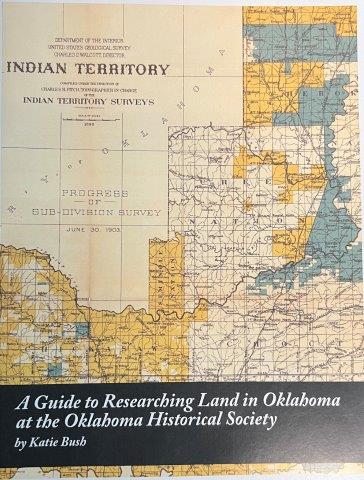
A Guide to Researching Land in Oklahoma at the Oklahoma Historical Society
Katie Bush
$15.00
A new state publication combines streamlined history, simplified maps, technical how-to, and a guide to sources to aid in Oklahoma land research. Bush condenses Oklahoma land history to the basics, from the Louisiana Purchase in 1803 to the Free Homes Act of 1900. In between, she recounts Indian removal, the Boomer movement, land runs and other U.S. public property dispersal, allotment of tribal land to individual members and freedmen, leasing, grafting and other history that underlies land title in Oklahoma. Anyone new at looking into government, tribal or personal ownership or control of property would find Bush's work useful, whether for genealogical or general research.
The 38-page guide is divided into four main sections.
• Creation of Oklahoma, including establishment of Indian Territory; Indian Removal Act; Organic Act that created Oklahoma Territory; and surveying of Indian Territory.
• Oklahoma Territory, including Boomer Movement and homesteads; Unassigned Lands; Iowa, Pottawatomie, and Sac and Fox reservations; Kickapoo Reservation; Cheyenne and Arapahoe Reservation; Greer County Neutral Strip; Land lotteries for Wichita, Caddo, Comanche, Kiowa, and Apache lands; and Big Pasture opened by sealed bid.
• Indian Territory, including Dawes Commission; use of land allotments to "civilize" American Indians; allotments to freedmen; safeguarding Indian lands from Boomers; dispute with railroads; grafters and the use of lease agreements; recording districts; Allotments (Tonkawa; Pawnee; Ponca and Otoe-Missouria; Osage and Kaw-Kansa; Choctaw and Chickasaw; Cherokee; Seminole; Muscogee-Creek); land allotments of tribes in northeastern Indian Territory (Seneca, Shawnee, and Quapaw; Peoria; Ottawa; Wyandotte; Modoc).
• Homesteading in Oklahoma, including rules; who qualified under the Homestead Act? special provisions for military servicemen; inheriting land if applicant dies/special cases; Free Homes Act of 1900; town sites; land entry case files/applications; simultaneous applications; and settlement and cultivation options.
The guide also has a section on obtaining government land documents, and "how to read legal descriptions for your ancestor's land patent."
It also has lists of records and archives held by the Oklahoma Historical Society, and contact information for the National Archives at Fort Worth, Texas, and every county clerk's office in Oklahoma.

